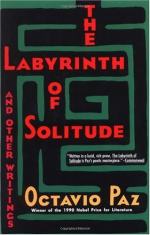
|
| Name: _________________________ | Period: ___________________ |
This test consists of 5 multiple choice questions, 5 short answer questions, and 10 short essay questions.
Multiple Choice Questions
1. In Paz's view, why does the Spaniard still use and enjoy blasphemy?
(a) Because he no longer believes in God.
(b) Because he curses for dramatic effect.
(c) Because he still believes in God.
(d) Because he cannot curse creatively.
2. Why are a woman's instincts those of a species rather than her own?
(a) She is the incarnation of the life force, which itself is impersonal.
(b) Her individual instincts are obliterated because of her proximity to the Divine.
(c) She must have instincts of the species in order to perpetuate the race.
(d) As an inferior person, she does not have individual instincts.
3. How does the pachuco present himself to the people around him?
(a) As a solitary, challenging figure.
(b) As a man searching for a home.
(c) As a lost man.
(d) As one of the group.
4. Why does a Mexican blend into his surroundings and become solely Appearance?
(a) He wants to end his individuality.
(b) He fears human interaction.
(c) He fears appearances.
(d) He loves appearance.
5. In Paz's estimation, what vital word has the Mexican forgotten?
(a) The word that gives him peace with all others.
(b) The word of love given to him by his mother.
(c) The word that allows him to reach out to others.
(d) The word tying him to life forces of creativity and destruction.
Short Answer Questions
1. In Paz's thought, what does a study of the great myths reveal?
2. What is the advantage of the North American view of women in relation to the Spanish view?
3. Why do Mexicans tell lies (Chapter Two)?
4. What happens when the Mexican dissimulates?
5. What is the difference between the Mexican killer and the modern one?
Short Essay Questions
1. What is the origin of the pachuco? How does that characterization prepare the reader for the rest of the book?
2. How important are fiestas in Mexican culture? What relationship exists between the fiesta and the individual?
3. Why does the Mexican love Form? Other than in personal relationships, how does that idea express itself?
4. What is the modern view of death? How is it dramatically different from the Aztec view?
5. What is the greatest horror that a worker suffers? Do you think that is true?
6. What is the character of the Mexican's solitude? How does it differ from the solitude of the North American?
7. Who is the Chingada? What relation does she hold to every Mexican, whether male or female?
8. What is dissimulation? How does it compare to lying? How does it affect the Mexican's idea of himself?
9. Who is the Virgin of Guadalupe? How is she an important part of Mexican identity?
10. How do Mexicans view their bodies? How does their view contribute to their wish for privacy?
|
This section contains 1,895 words (approx. 7 pages at 300 words per page) |

|




